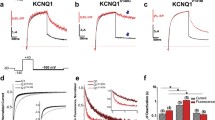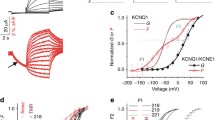Abstract
Cardiac slow delayed rectifier (IKs) channel complex consists of KCNQ1 channel and KCNE1 auxiliary subunits. The extracellular juxtamembranous region of KCNE1 is an unstructured loop that contacts multiple KCNQ1 positions in a gating-state-dependent manner. Congenital arrhythmia-related mutations have been identified in the extracellular S1–S2 linker of KCNQ1. These mutations manifest abnormal phenotypes only when coexpressed with KCNE1, pointing to the importance of proper KCNQ1/KCNE1 interactions here in IKs channel function. We investigate the interactions between the KCNE1 loop (positions 36–47) and KCNQ1 S1–S2 linker (positions 140–148) by means of disulfide trapping and voltage clamp techniques. During transitions among the resting-state conformations, KCNE1 positions 36–43 make contacts with KCNQ1 positions 144, 145, and 147 in a parallel fashion. During conformational changes in the activated state, KCNE1 position 40 can make contacts with all three KCNQ1 positions, while the neighboring KCNE1 positions (36, 38, 39, and 41) can make contact with KCNQ1 position 147. Furthermore, KCNQ1 positions 143 and 146 are high-impact positions that cannot tolerate cysteine substitution. To maintain the proper IKs channel function, position 143 requires a small side chain with a hydroxyl group, and position 146 requires a negatively charged side chain. These data and the proposed molecular motions provide insights into the mechanisms by which mutations in the extracellular juxtamembranous region of the IKs channel impair its function.













Similar content being viewed by others
References
Bendahhou S, Marionneau C, Haurogne K, Larroque MM, Derand R, Szuts V, Escande D, Demolombe S, Barhanin J (2005) In vitro molecular interactions and distribution of KCNE family with KCNQ1 in the human heart. Cardiovasc Res 67:529–538
Campos FV, Chanda B, Roux B, Bezanilla F (2007) Two atomic constraints unambiguously position the S4 segment relative to S1 and S2 segments in the closed state of Shaker K channel. Proc Natl Acad Sci USA 104:7904–7909
Careaga CL, Falke JJ (1992) Thermal motions of surface α-helices in the d-galactose chemosensory receptor. Detection by disulfide trapping. J Mol Biol 226:1219–1235
Castagnetto JM, Hennessy SW, Roberts VA, Getzoff ED, Tainer JA, Pique ME (2002) MDB: the mtalloprotein database and browser at the Scripps Research Institute. Nucleic Acids Res 30:379–382
Chen H, Kim LA, Rajan S, Xu S, Goldstein SAN (2003a) Charybdotoxin binding in the IKs pore demonstrates two minK subunits in each channel complex. Neuron 40:15–23
Chen YH, Xu SJ, Bendahhou S, Wang XL, Wang Y, Xu WY, Jin HW, Sun H, Su XY, Zhuang QN, Yang YQ, Li YB, Liu Y, Xu HJ, Li XF, Ma N, Mou CP, Chen Z, Barhanin J, Huang W (2003b) KCNQ1 gain-of-function mutation in familial atrial fibrillation. Science 299:251–254
Chung DY, Chan PJ, Bankston JR, Yang L, Liu G, Marx SO, Karlin A, Kass RS (2009) Location of KCNE1 relative to KCNQ1 in the IKs potassium channel by disulfide cross-linking of substituted cysteines. Proc Natl Acad Sci USA 106:743–748
Cuello LG, Cortes DM, Perozo E (2004) Molecular architecture of the KvAP voltage-dependent K+ channel in a lipid bilayer. Science 306:491–495
Fan JS, Jiang M, Dun W, McDonald TV, Tseng GN (1999) Effects of outer mouth mutations on hERG channel function: a comparison with similar mutations in Shaker. Biophys J 76:3128–3140
Ghosh S, Nunziato DA, Pitt GS (2006) KCNQ1 assembly and function is blocked by long-QT syndrome mutations that disrupt interaction with calmodulin. Circ Res 98:1048–1054
Grunnet M, Olesen SP, Klaerke DA, Jespersen T (2005) hKCNE4 inhibits the hKCNQ1 potassium current without affecting the activation kinetics. Biochem Biophys Res Commun 328:1146–1153
Haitin Y, Wiener R, Shaham D, Peretz A, Cohen EBT, Shamgar L, Pongs O, Hirsch JA, Attali B (2009) Intracellular domains interactions and gating motions of IKs potassium channel subunits. EMBO J 28:1994–2005
Hong K, Piper DR, Diaz-Valdecantos A, Brugada J, Oliva A, Burashnikov E, Santos-de-Soto J, Grueso-Montero J, Diaz-Enfante E, Brugada P, Saches F, Sanguinetti MC, Brugada R (2005) De novo KCNQ1 mutation responsible for atrial fibrillation and short QT syndrome in utero. Cardiovasc Res 68:433–440
Jost M, Virag L, Bitay M, Takacs J, Lengyel C, Biliczki P, Nagy Z, Bogats G, Lathrop DA, Papp JG, Varro A (2005) Restricting excessive cardiac action potential and QT prolongation. A vital role for IKs in human ventricular muscle. Circulation 112:1392–1399
Kang C, Tian C, Sonnichsen FD, Smith JA, Meiler J, George AL Jr, Vanoye CG, Kim HJ, Sanders CR (2008) Structure of KCNE1 and implications for how it modulates the KCNQ1 potassium channel. Biochemistry 47:7999–8006
Kapplinger JD, Tester DJ, Salisbury BA, Carr JL, Harris-Kerr C, Pollevick GD, Wilde AAM, Ackerman MJ (2009) Spectrum and prevalence of mutations from the first 2500 consecutive unrelated patients referred for the FAMILION long QT syndrome genetic test. Heart Rhythm 6:1297–1303
Kurokawa J, Bankston JR, Kaihara A, Chen L, Furukawa T, Kass RS (2009) KCNE variants reveal a critical role of the β subunit carboxyl terminus in PKA-dependent regulation of the IKs potassium channel. Channels 3:1–9
Liu WL, Hu DY, Li P, Li CL, Qin XG, Li YT, Li L, Li ZM, Dong W, Qi Y, Wang Q (2006) Novel mutations of potassium channel KCNQ1 S143L and KCNH2 Y475C genes in Chinese pedigrees of long QT syndrome. Zhonghua Nei Ke Za Zhi 45:463–466
Liu XS, Zhang M, Jiang M, Wu DM, Tseng GN (2007) Probing the interaction between KCNE2 and KCNQ1 in the transmembrane region. J Memb Biol 216:117–127
Long SB, Campbell EB, MacKinnon R (2005) Crystal structure of a mammalian voltage-dependent Shaker family K+ channel. Science 309:897–903
Lundby A, Raven LS, Svendsen JH, Olesen SP, Schmitt N (2007) KCNQ1 mutation Q147R is associated with atrial fibrillation and prolonged QT-interval. Heart Rhythm 4:1532–1541
Lundquist AL, Manderfield LJ, Vanoye CG, Rogers CS, Donahue BS, Chang PA, Drinkwater DC, Murray KT, George AL Jr (2005) Expression of multiple KCNE genes in human heart may enable variable modulation of IKs. J Mol Cell Cardiol 38:277–287
Lvov A, Gage SD, Berrios VM, Kobertz WR (2010) Identification of a protein–protein interaction between KCNE1 and the activation gate machinery of KCNQ1. J Gen Physiol 135:607–618
Melman YF, Demenech A, de la Luna S, McDonald TV (2001) Structural determinants of KvLQT1 control by the KCNE1 family of proteins. J Biol Chem 276:6439–6444
Morin TJ, Kobertz WR (2008) Counting membrane-embedded KCNE β-subunits in functioning K+ channel complexes. Proc Natl Acad Sci USA 105:1478–1482
Nakajo K, Kubo Y (2007) KCNE1 and KCNE3 stabilize and/or slow voltage sensing S4 segment of KCNQ1 channel. J Gen Physiol 130:269–281
Nakajo K, Ulbrich MH, Kubo Y, Isacoff EY (2010) Stoichiometry of the KCNQ1–KCNE1 ion channel complex. Proc Natl Acad Sci USA 107:18862–18867
Napolitano C, Priori SG, Schwartz PJ, Bloise R, Ronchetti E, Nastoli J, Bottelli G, Cerrone M, Leonardi S (2005) Genetic testing in the long QT syndrome. Development and validation of an efficient approach to genotyping in clinical practice. JAMA 294:2975–2980
Panaghie G, Tai KK, Abbott GW (2006) Interaction of KCNE subunits with the KCNQ1 K+ channel pore. J Physiol 570:455–467
Radicke S, Dotella D, Graf EM, Banse U, Jost N, Varro A, Tseng GN, Ravens U, Wettwer E (2006) Functional modulation of the transient outward current Ito by KCNE β-subunits and regional distribution in human non-failing and failing hearts. Cardiovasc Res 71:695–703
Sanguinetti MC, Curran ME, Zou A, Shen J, Spector PS, Atkinson DL, Keating MT (1996) Coassembly of KvLQT1 and minK (IsK) proteins to form cardiac IKs potassium channel. Nature 384:80–83
Schreibmayer W, Lester HA, Dascal N (1994) Voltage clamping of Xenopus laevis oocytes utilizing agarose-cushion electrodes. Pflugers Arch 426:453–458
Sesti F, Goldstein SAN (1998) Single-channel characteristics of wild-type IKs channels and channels formed with two minK mutants that cause long QT syndrome. J Gen Physiol 112:651–663
Shamgar L, Ma L, Schmitt N, Haitin Y, Peretz A, Wiener R, Hirsch J, Pongs O, Attali B (2006) Calmodulin is essential for cardiac IKs channel gating and assembly. Impaired function in long-QT mutations. Circ Res 98:1055–1063
Splawski I, Shen J, Timothy KW, Lehmann MH, Priori SG, Robinson JL, Moss AJ, Schwartz PJ, Towbin JA, Vincent GM, Keating MT (2000) Spectrum of mutations in long-QT syndrome genes KvLQT1, HERG, SCN5A, KCNE1, and KCNE2. Circulation 102:1178–1185
Tai KK, Goldstein SAN (1998) The conduction pore of a cardiac potassium channel. Nature 391:605–608
Tapper AR, George AL Jr (2001) Location and orientation of minK within the IKs potassium channel complex. J Biol Chem 276:38249–38254
Tseng-Crank JCL, Tseng GN, Schwartz A, Tanouye MA (1990) Molecular cloning and functional expression of a potassium channel cDNA isolated from a rat cardiac library. FEBS Lett 268:63–68
Wiener R, Haitin Y, Shamgar L, Fernandez-Alonso MC, Martos A, Chomsky-Hecht O, Rivas G, Attali B, Hirsch JA (2008) The KCNQ1 (Kv7.1) COOH terminus, a multitiered scaffold for subunit assembly and protein interaction. J Biol Chem 283:5815–5830
Wu DM, Lai LP, Zhang M, Wang HL, Jiang M, Liu XS, Tseng GN (2006) Characterization of an LQT5-related mutation in KCNE1, Y81C: implications for a role of KCNE1 cytoplasmic domain in IKs channel function. Heart Rhythm 3:1031–1040
Xu XL, Jiang M, Hsu KL, Zhang M, Tseng GN (2008) KCNQ1 and KCNE1 in the IKs channel complex make state-dependent contacts in their extracellular domains. J Gen Physiol 131:589–603
Yang Y, Sigworth FJ (1998) Single-channel properties of IKs potassium channels. J Gen Physiol 112:665–678
Zareba W, Moss AJ, Sheu G, Kaufman ES, Priori SG, Vincent GM, Towbin JA, Benhorin J, Schwartz PJ, Napolitano C, Hall WJ, Keating MT, Qi M, Robinson JL, Andrews AL (2003) Location of mutation in the KCNQ1 and phenotype presentation of long QT syndrome. J Cardiovasc Electrophysiol 14:1149–1153
Acknowledgments
This study was supported by RO1 HL67840 from National Heart, Lung and Blood Institute, and R21 AT0044601 from National Center for Complementary and Alternative Medicine, of National Institutes of Health (to GNT).
Author information
Authors and Affiliations
Corresponding author
Electronic supplementary material
Below is the link to the electronic supplementary material.
Rights and permissions
About this article
Cite this article
Wang, Y.H., Jiang, M., Xu, X.L. et al. Gating-Related Molecular Motions in the Extracellular Domain of the IKs Channel: Implications for IKs Channelopathy. J Membrane Biol 239, 137–156 (2011). https://doi.org/10.1007/s00232-010-9333-7
Received:
Accepted:
Published:
Issue Date:
DOI: https://doi.org/10.1007/s00232-010-9333-7




